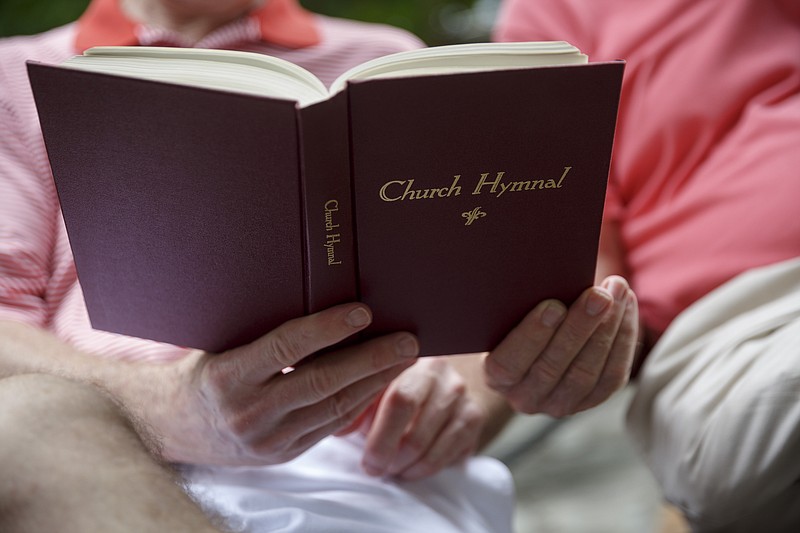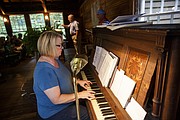Photo Gallery
Red-Back Hymnal returns: Well-known book of hymns grows in popularity across the South
If you go
› What: Red-Back Hymnal Singing at Hullender Farm› Where: 10944 London Lane, Apison, Tenn.› When: 6 p.m. Sunday, Sept. 18› What: Red-Back Hymnal Singing at Little Brown Church› Where: 3209 Spring Ave., Signal Mountain› When: 5-7 p.m. Sunday, Oct. 16
Red-Back Hymnal exhibits
A permanent exhibit acknowledging Cleveland, Tenn., as the birthplace of “The Church Hymnal” is located inside the Museum Center at Five Points, 200 E. Inman St., in Cleveland.“The Red Back: America’s Best-Loved Hymnal” shares the history of the hymnal from its first printing in Cleveland to its widespread adoption and continuing influence on Christian music. An interactive touchscreen offers commentary by local gospel musicians on the history of the Red-Back Hymnal and a listening station allows visitors to hear some of its famous songs.The museum is open 10 a.m.-5 p.m. Tuesdays-Fridays, 10 a.m.-3 p.m. Saturdays. Admission for nonmembers is $5 ages 6 and older.
On the 65th anniversary of its publishing, and 50 years after the peak of its popularity, a beloved hymnal is finding its way back into the hands of singers of all denominations.
Whether due to nostalgia of baby boomers or the novelty to millennials of singing harmony on church music, "The Church Hymnal " - dubbed the Red-Back Hymnal due to its maroon hardback cover - is making a comeback.
Around the South, a growing number of interdenominational groups are gathering together to sing old favorites from the Red-Back. Although the hymnal is printed in shape notes - a type of musical notation designed to make it easier for congregational and community singing - these songfests are not shape-note singings as seen in the movie "Cold Mountain." They are gospel gatherings, singing old hymns that have stood the test of time.
Bill Hullender, Hamilton County trustee, has been hosting a Red-Back hymn singing at his farm in Apison on the third Sunday of each month; it averages 150 singers. The singings are free and open to the public, however, a love offering is usually taken for any special performers. Heritage Quartet, for instance, will be featured on Sept. 18.
"I've just always loved the old Southern gospel songs," Hullender explains. "A group of us used to go down to Alabama years ago when the Alabama Boys would have their country music singings in Fort Payne. There was a group that started a Southern gospel singing on Friday nights and we would go down for that in the '80s. In most churches today you hear praise music, but I love Southern gospel."
"The Church Hymnal" was found in pews of multiple denominations from the 1950s through the early 1970s. It was published in November 1951 by Tennessee Music and Printing Co., the publishing division of the Church of God based in Cleveland, Tenn., and was unique because it was a collection of popular hymns, old-time gospel favorites and songs to celebrate ecumenical holidays all in one collection.
"I think there is a little bit of nostalgia in these hymn singings. For people in their 60s and 70s, it's going back to their roots," says Dr. Donald LeRoy, music minister at West Metro Church of God in Douglasville, Ga. "For younger people, it's just new music to them. It's fun to sing, especially singing harmony. A lot of the new contemporary music doesn't have much harmony."
One of its most popular gospel hymns, "Just a Little Talk With Jesus," was written by the late Rev. Cleavant Derricks, a Chattanoogan who was inducted into the Gospel Music Hall of Fame in 2001.
Dr. David Roebuck, church historian for the Church of God, director of the Dixon Pentecostal Research Center and assistant professor of History of Christianity at Lee University in Cleveland, says the "primary attraction of many of these songs is that they are testimony songs, songs of journey."
"We are people who are on a journey and to sing about that journey is important to us," says Roebuck. "They are often songs about heaven and hope in the future. In challenging times, people call on their faith to give them hope."
Musicians Max Morris and Jack Clark have organized Red-Back hymn singings that are held eight times a year in Cleveland, rotating among churches, says Roebuck.
Roebuck adds that the Red-Back Hymnal also was unusual because the majority of songbooks of its era were paperbacks, designed to be used for a few months then thrown away since publishers wanted consumers to buy their next songbook.
"The fact it was hardback and a collection of the most popular songs of its day gave the Red-Back Hymnal lasting value and helped it hang around longer than those expected to wear out," he says.
By the 1960s, the Red-Back's popularity was peaking. However, its use began to decline with the emergence of choirs leading congregational music in 1970s and continued to decrease with the introduction of praise music in the 1990s, says Roebuck. After the addition of technology to worship services - including big-screen projections of lyrics to praise songs - "we stopped using hymn books altogether by the 21st century," he says.
Last month, a new Red-Back hymn singing began on Signal Mountain. Organizer Yvonne Harvey says 175 attended the first one in the Little Brown Church. The next will be Oct. 16 at the church, then organizers will move locations to Signal Mountain's Bachman Community Center for the winter.
She and her husband, Mike, decided to launch a local singing after attending the well-known Red-Back singings at Gardendale First Baptist Church in Gardendale, Ala.
"The large megachurch was filled to capacity with all denominations coming in from several states," she says. "The experience took Mike back to his roots in the old hymns that have been replaced by contemporary music. Mike wanted to do something to help preserve the old hymns."
She says the first singing on Signal Mountain convinced her "there appears to be a renewed hunger for the old hymns."
"I think parents want to teach the history and meaning of 'Amazing Grace' and other hymns to their children, she says. "There is deep history and life lessons found in hymns that still resonate and connect with people today that contemporary music lacks. Their message never grows old."
Contact Susan Pierce at spierce@timesfreepress.com or 423-757-6284.

